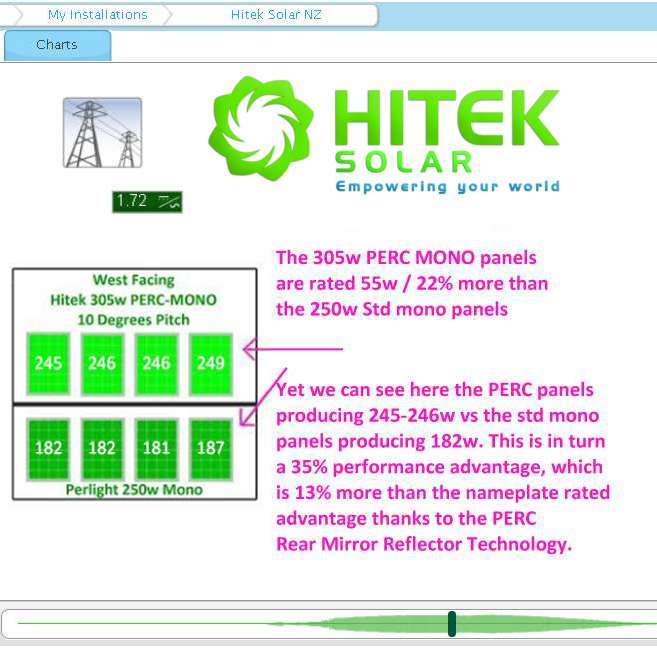Many people often assume (wrongly) that all solar panels are created equally, and they just base their decision (mostly) on the nameplate rating of a panel (eg a 250w panel), but as we can below in our own testing comparing standard 250w mono solar panels against latest 305w PERC MONO technology, this is not actually the case in the real world power output.
Using the world famous Tigo Energy panel level monitoring system to report the live power ratings for every panel on our site, we can clearly see that even though there's only a 55w / 22% nameplate difference in wattage between these panels, there's actually up to a 35% power output compared with a standard 250w mono / poly panel. This actually ends up being 13% more power output than the nameplate rated difference as an advantage in terms of the REAL WORLD energy output from the PERC MONO panels during our own testing on our live test site in Mt Maunganui Tauranga (New Zealand).
In the best cases we’ve even observed up to 50% more real world power output from our 305w PERC MONO panels compared with a standard 300w mono / poly panel during our NZ testing. This translates to a difference of 3.5Amps output vs 7.5Amps output going into the clients battery on the same roof top when testing with 1 std panel vs one of our PERC MONO panels.

For people who care about the output of their on-grid, hybrid or off-grid system yearly output and especially their Winter, Autumn and Spring power production then PERC mono panels are certainly something well worth considering (even though they do cost a little more per panel) as they actually deliver some good real world efficiency gains (up to 13% more during our own testing) thanks to high efficiency latest technology cells with tiny mirror reflectors in the rear of the cells.
Typically the difference in cost is usually only around a small $80-110 cost extra (per panel), yet this extra cost often pays for itself within the first few years of running an off-grid system due to saving needing to run the generator for as many hours throughout the year. Nowdays the solar panels themselves are actually one of the cheapest parts of a good solar power system, where as only 5 years ago the solar panels themselves were one of the largest costs of the entire system.
Things such as alloy racking / mounting kit prices have stayed about the same and labour prices have actually increased, and everyone seems to be running out of good (un-shaded) roof top areas, so the real question is WHY would people want to waste their time, money and roof space installing low efficiency panels when once the "TRUE COSTS" are actually calculated it actually makes better sense to install latest technology higher efficiency panels in many cases.
One of our clients (Kevin in Kerikeri) had installed 12 x Hyundai 265w (3.48kW) of mono panels on his roof 1 year ago, and then this year he installed an additional 10 of our 290w (2.9kW) of our PERC MONO panels (on a different string so that the 2 sets of panels would not affect each other), and the 2.9kW of PERC MONO panels actually produced MORE power output each day even though there was 580watts less of panels installed. Yes before you ask all the panels were on the exact same roof top, facing the same orientation & tilt angle etc. He was shocked with how much extra power the PERC MONO panels were producing for his site each day and he now felt that the existing MONO / POLY technology had now been "Outdated and Supersceeded by these new high efficiency PERC MONO panels".
Note: We have also ran the same tests on our 290w, 295w, 300w and 305w PERC MONO panels to also verify that they too show the same level of increased power production compared with standard panels, and yes all of our PERC MONO panels showed this additional power output.
For those of you who want to read up about the technology behind PERC MONO panels that help them achieve this extra output, then please read this article here: Why are high efficiency PERC MONO solar panels becoming popular?
The above link is well worth your 5 minutes of time spent reading through and you will learn alot.
Recently there has been a lot of media attention around the proposition of long term solar power leasing agreements. Solar Long term leasing is a term that is being talked about more commonly nowdays, but is it really actually viable in reality??
The concept is that you receive your solar panels and installation for ‘free’, and you in turn sign a long term lease agreement for 20 years (where they own the system on your roof top and will never own it).
To read more about the viability of long term solar leasing agreements, Frank and Muriel Newman from the Oily Rag have written an interesting article, featured in the Bay of Plenty Times.
We think it’s a good read, and raises some very interesting points, and compared to adding it onto your mortgage or buying the system outright, it's easy to see that the "TRUE REAL PAYBACK RETURN BENEFITS" of Solar Power Systems from the likes of what Solar City is offering with their Solar Zero system offerings don't compare against owning the system yourself. Why pay to make somebody else rich, when you could be making ALL of the savings yourself instead of lining their pockets?
Original Article Published Below by Oily Rag:
Authors: Frank and Muriel Newman, authors of Living Off the Smell of an Oily Rag in NZ. To read more of their content and follow them online, please visit their website.
Featured: Bay Of Plenty Times, Thursday April 16th 2015. Original article source:
Some say that solar power is the way of the future, but that the stumbling block has been the high upfront cost of solar panels. So there was a ripple of excitement within the oily rag community recently, caused by a media headline. “Free panels place solar power within reach for Kiwis,” it exclaimed.
However, on further reading, it is apparent that while there are lots of free things for the frugally minded, solar power is not yet one of them.
The story was about a company called solarcity, which recently went nationwide with a new solar power option called solarZero, whereby homeowners can get solar panels installed on their roof at no upfront cost — as long as they make a 20-year commitment to pay a fixed monthly fee. According to the company this is a first for New Zealand but is not uncommon overseas.
The “zero upfront” deal involves the householder entering into what is, in effect, a rental and servicing agreement. At no stage does ownership of the panels pass to the householder.
The monthly fee ranges from $55 to $280, depending on the number of panels that need to be installed, which in turn depends on the power consumption of the household.
The website has some handy calculators to show the potential savings. For example, a “normal” household (not that oily rag households are normal!) that pays $300 a month in power bills would save about $119, but out of that they would have to pay $110 a month to solarcity. Over the 20-year period of the contract, the payments would total $26,400.
The net savings to the householder would therefore be $9 a month ($119 less the $110 fee), or 3 per cent of their power bill. In other words, the energy cost savings of $119 are split $9 to the householder and $110 to the solar panel provider.
Since solar power is only generated during the day and storage cells are not included in the deal, customers would still have to buy power from their electricity company for night-time use.
Although solarcity has provided a new option for those wanting to make a switch to solar energy, committing to 240 monthly payments is a big, long-term financial undertaking that requires a good deal of serious thought.
What happens if you were to sell your house within the 20 years (quite likely given the frequency with which people move house)? In that case you would have a number of choices: convince the new owner to take over the remaining payments, pay to relocate the panels to your new home, or pay upfront the remaining payments due.
To read mor
For example, if someone 10 years into the 20-year commitment moves in to a rest home and is not able to convince the new homeowner to take over their contract, they would be left, in our example, with a bill of $13,200.
Some may say solar panels add to the resale value of a home …we doubt that and take the view that the rate of innovation is such that the units may be of little or no value.
It is also questionable whether it is wise to make a 20-year commitment to a solar power system, when the solar industry is undergoing rapid improvements in technology. The cost of solar power units has fallen significantly over the years and we don’t see any reason why this will not continue.
Solar energy may be the way of the future, given the vast roof areas that could be used to capture the sun’s energy. However, having done some number crunching, we are not convinced that a very long-term rental agreement with its inherent uncertainties is as attractive as it might sound. Householders should consider the upfront capital payments and assess the saving in energy costs as a return on their investment.
You can send in your ideas and join the Oily Rag mailing list, by emailing us at tips@oilyrag.co.nz or by writing to us at: Living Off the Smell of an Oily Rag, PO Box 984, Whangarei.
Frank and Muriel Newman are the authors of Living Off the Smell of an Oily Rag in NZ. Read our wealth of tips at Oily Rag.

